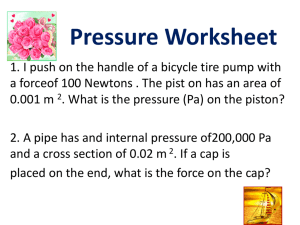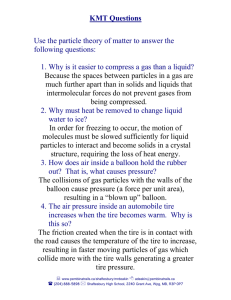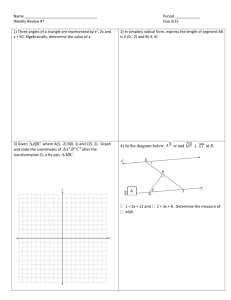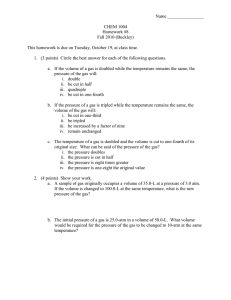GHRowell 1 A legendary story on college campuses concerns two students who...
advertisement
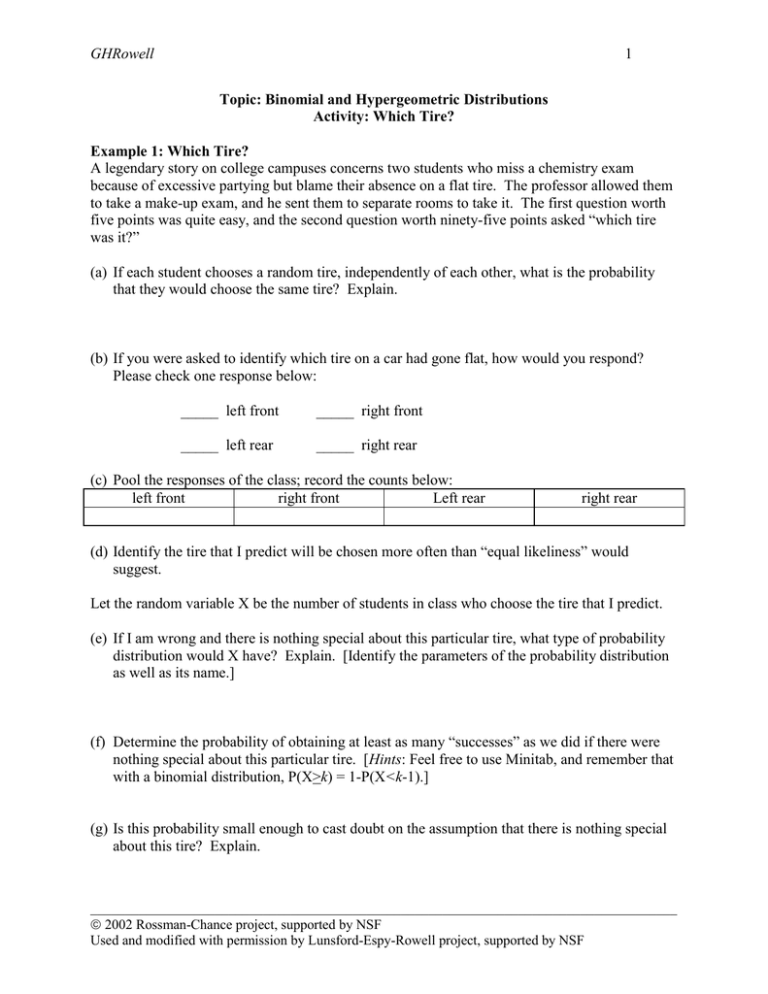
GHRowell 1 Topic: Binomial and Hypergeometric Distributions Activity: Which Tire? Example 1: Which Tire? A legendary story on college campuses concerns two students who miss a chemistry exam because of excessive partying but blame their absence on a flat tire. The professor allowed them to take a make-up exam, and he sent them to separate rooms to take it. The first question worth five points was quite easy, and the second question worth ninety-five points asked “which tire was it?” (a) If each student chooses a random tire, independently of each other, what is the probability that they would choose the same tire? Explain. (b) If you were asked to identify which tire on a car had gone flat, how would you respond? Please check one response below: _____ left front _____ right front _____ left rear _____ right rear (c) Pool the responses of the class; record the counts below: left front right front Left rear right rear (d) Identify the tire that I predict will be chosen more often than “equal likeliness” would suggest. Let the random variable X be the number of students in class who choose the tire that I predict. (e) If I am wrong and there is nothing special about this particular tire, what type of probability distribution would X have? Explain. [Identify the parameters of the probability distribution as well as its name.] (f) Determine the probability of obtaining at least as many “successes” as we did if there were nothing special about this particular tire. [Hints: Feel free to use Minitab, and remember that with a binomial distribution, P(X>k) = 1-P(X<k-1).] (g) Is this probability small enough to cast doubt on the assumption that there is nothing special about this tire? Explain. _____________________________________________________________________________________ 2002 Rossman-Chance project, supported by NSF Used and modified with permission by Lunsford-Espy-Rowell project, supported by NSF GHRowell 2 This probability is called a p-value of a statistical test of significance. [When you earlier analyzed the psychology experiment about playing a video game with an observer watching, you approximated a p-value by simulation and then calculated it exactly with hypergeometric probabilities.] If this p-value is very small, that reveals that the observed results would be very unlikely to occur by chance variation if there was nothing special about the tire in question. This in turn provides evidence against the hypothesis that the tire has probability 1/4 of being chosen in favor of the alternative that this tire is chosen more than 1/4 of the time. [Note: .05 is the most commonly used criterion to designate “very small,” with .10 and .01 also common choices.] If this p-value is not very small, that suggests that one can not rule out chance variation as an explanation for the sample result and therefore provides little or no evidence against the hypothesis of equal likeliness. The smaller the p-value, the stronger the evidence against the “nothing special” hypothesis in favor of the alternative that people choose this tire more often than equal likeliness would suggest. (h) How many people would have to choose this tire in order for the probability of that happening by chance, if there were nothing special about the tire, to be no greater than .05? [Hints: Use Minitab, first with trial-and-error until you determine the desired value. Then verify your answer with Minitab’s “inverse cumulative probability option (using the value .95) under Calc> Probability Distributions> Binomial.] Your calculation has identified the rejection region of the test, defined to be the values of the random variable that will lead you to reject the “nothing special” hypothesis. Now suppose that the tire of interest is chosen by 30% of a sample of people. (i) Would you find this to be convincing evidence that the long-run probability of choosing this tire is more than 1/4? What further information would you need? (j) For the sample sizes n listed in the table below, find the probability of obtaining 30% or more “successes” if the long-run probability of “success” were p=1/4. [Hint: Use Minitab.] sample size 20 50 100 200 500 P(30% or more) (k) In which of these cases would you be reasonably convinced that p>1/4? Explain. The strength of evidence against a hypothesis depends on the sample size involved. Similar results provide more compelling evidence with larger sample sizes than with smaller ones. _____________________________________________________________________________________ 2002 Rossman-Chance project, supported by NSF Used and modified with permission by Lunsford-Espy-Rowell project, supported by NSF GHRowell 3 Example 2: Sampling Suppose that in a population of 10 items, 3 are defective and 7 are not. Suppose that two items are chosen at random for inspection. Let X be the number of defective items inspected. (a) Explain why X does not have a binomial distribution. [Hint: Which of the binomial conditions is not satisfied here?] (b) How could you change the sampling process so that X would indeed follow a binomial distribution? Explain. We have previously discussed hypergeometric probabilities, which arise when one takes a random sample without replacement from a population containing a certain number of “successes” and a certain number of “failures.” The random variable X= number of successes in sample is said to follow a hypergeometric distribution. Its parameters are the population size N, the sample size n, and the number of “successes” in the population M. Its probability mass function follows from our earlier study of hypergeometric probabilities: M N M M x n x . Its expected value and variance are E ( X ) n and P( X x) N N n V (X ) n M M N n 1 . N N N 1 (c) Determine the probability distribution of X. Record it in the second row of the table below: number defective 0 1 2 N=10 N=100 N=1000 N=10,000 binomial (d) Verify your answers to (c) using Minitab. First put the values 0, 1, and 2 into c1, and then use Calc> Probability Distributions> Hypergeometric. Click on “probability,” enter the appropriate parameters, and select “input column” with c1 as that column and c2 for optional storage. [Note that since we are counting the number of defectives in the sample, “success” means defective.] (e) Now find the probability distribution of X assuming that the population size were N=100, with 30 defective and 70 not. [You may use Minitab.] Record it in the table above. (f) Repeat (e) for a population size of N=1000, with 300 defective and 700 not. _____________________________________________________________________________________ 2002 Rossman-Chance project, supported by NSF Used and modified with permission by Lunsford-Espy-Rowell project, supported by NSF GHRowell 4 (g) Repeat (e) for a population size of N=10,000, with 3000 defective and 7000 not. If the sampling had been with replacement, then X would have followed a binomial distribution with n = 2 and p = M/N = .3. (h) Determine this probability distribution, and record it in the bottom row of the table above. (i) Does the binomial distribution do a good job of approximating the hypergeometric distribution in any of these cases? Explain why this makes sense. When the population size is large relative to the sample size, then sampling without replacement is not much different than sampling with replacement (because the probability of “success” changes very little even as successes and failures are drawn from the population. In this case the binomial distribution with p = M/N provides an effective approximation to the hypergeometric distribution. Our rule-of-thumb will be that if the population size is at least 20 times the sample size (N > 20n), then the binomial distribution closely approximates the hypergeometric. Consider the population of roughly 200 million adult Americans. Suppose that 110 million favor candidate A in an upcoming election and 90 million favor candidate B. Suppose that a sample of 1000 is to be chosen at random. Let X be the number on the sample who favor candidate A. (j) Identify the (exact) probability distribution of X (its name and its parameter values). Then identify a probability distribution that could be used to approximate X (also its name and parameter values). Do you expect the approximation to be accurate here? Explain. (k) Determine the exact mean and standard deviation of X. Then calculate the mean and standard deviation for the approximate distribution. Are they very close? _____________________________________________________________________________________ 2002 Rossman-Chance project, supported by NSF Used and modified with permission by Lunsford-Espy-Rowell project, supported by NSF


